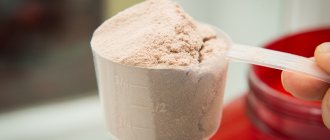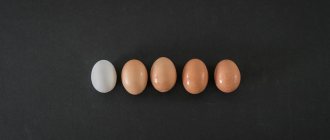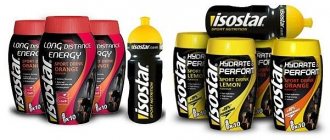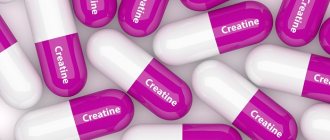When talking about sports nutrition, it is impossible not to talk about this type of protein, casein. Casein protein , both in the world of amateur fitness and in the world of professional bodybuilding, is a widely used supplement that ranks next to whey protein in its popularity and biological value. But their most important difference is the degree of digestibility and the immediate purpose of the intake. You can learn everything about protein from my previous articles: Which protein to choose? Choosing the right protein for weight loss and Proteins for girls: debriefing and my personal opinion. Today I want to dwell on casein and answer the following questions: can girls take casein? Which casein is better ? How to choose the right casein protein ? What is better casein for weight loss or low-fat cottage cheese? The answers to all these and many other questions that interest you are in this article.
Natural Sources of Casein
Sports cocktails contain 70% protein and an increased amount of complex carbohydrates with microelements. This loading dose in an accelerated manner affects the growth and restoration of muscle mass in athletes.
But an indispensable product for strength training, it does not replace a full meal. The drink is included in the diet as an additional source for health and muscle development.
Protein powders can replace casein in milk, cottage cheese or hard cheese. But only if you create a balanced diet. And also include a list of other healthy products in the menu:
- Vegetables fruits;
- Cereals, nuts;
- Eggs, meat;
- Seafood.
Dutch cheese contains the most casein – 26.8 g, and butter – only 0.6 g per 100 grams of product.
If a person plays sports, the daily dose to maintain muscle tone should be 40 g. And when creating a diet, you need to remember that casein in dairy products is absorbed more slowly. It is useful in the morning, before bed or in between meals. Whey protein is best used before or after training.
Casein in cottage cheese
| Varieties | Amount of proteins (g) per 100 grams of product |
| Grained with cream | 13 |
| Fat, 18% | 14 |
| Dietary | 16 |
| Bold, 9% | 16.7 |
| Low fat, 3% | 17.2 |
| Low fat, 0% | 18 |
Casein in milk
The amount of casein increases as the product is concentrated.
| Products | Protein content per 100 g |
| Cow pasteurized | 2.8 |
| Protein | 4.3 |
| Condensed | 7.2 |
| Dry | 25.6 |
What does casein contain?
The main sources of casein are dairy products. Goat and cow's milk contain it in an amount of about 80%, hard cheeses - 30%, full-fat cottage cheese - 22%, low-fat cottage cheese - 18%, kefir and yogurt - about 15%.
With such a phenomenon as casein allergy, certain dietary restrictions will be necessary. If we are talking about a baby, then the mother needs to adhere to a special hypoallergenic diet. If this does not work, the baby is transferred to formulas containing hydrolyzed goat milk proteins.
When this is also ineffective, juice-based mixtures are used. In older children and adults, milk and products containing it are eliminated from the diet and replaced with plant foods: different types of cabbage, nuts, cereals, legumes, and leafy vegetables.
Properties of casein
Casein or caseinogen is the second major protein in milk. Contains essential amino acids that are not produced by the body, but are needed for proper functioning:
- Has a beneficial effect on the condition of the intestines.
- Supports hemoglobin synthesis.
- Stimulates the protective properties of the immune system.
- Prevents the development of pathogenic microorganisms.
- As a building material, it improves the growth of hair and nails.
- As a source of phosphorus and calcium, it strengthens bones and teeth.
- Reduces susceptibility to infections and ARVI.
Benefit
Casein is useful for weight loss because it is slowly absorbed in the stomach. The feeling of fullness is maintained for 5-8 hours, which prevents snacking. A protein diet helps burn fat deposits and maintain normal body weight.
In sports nutrition, it increases strength and preserves muscles with a lack of calories. When, as a result of strength training, the body loses energy and seeks replenishment of reserves in the tissues.
Harm
The use of drugs with casein (except micellar) causes a number of side effects: bloating and abdominal pain, vomiting, diarrhea.
- Excessive intake of the substance into the body also negatively affects the health of the kidneys and liver.
- Contraindications for use: allergy to milk protein, individual intolerance.
- The cause of the malaise may not be casein, but the content of sodium and related enzymes in the preparation.
- The composition should not contain synthetic elements and vegetable fats.
Casein and insulin index
Unlike low-fat cottage cheese and whey protein, in which the amount of lactose is quite high (more than 3 g), micellar casein completely free of lactose. This suggests that the insulin index of casein will be much lower than that of cottage cheese. But this is only true for micellar casein , which has been subject to more detailed purification and filtration of carbohydrates, unlike its cheap brother calcium caseinate.
It turns out that casein is still preferable to cottage cheese precisely because of its low lactose content. So, if you have lactose intolerance, or your goal is to lose weight, and in the evening you suddenly want to eat cottage cheese, then it is better to drink a portion of micellar casein diluted IN WATER. I emphasize the phrase “on water” for a reason, because if you dilute a casein cocktail in milk, then the whole meaning of the “operation” will immediately be lost, since milk contains a lot of lactose, and all of it will instantly end up in your casein. So if you decide to satisfy your hunger with a portion of casein in the evening, then dilute it only in water. At the same time, remember:
! If you are losing weight, then drink casein 1.5-2 hours before bedtime, but if you do not pursue such a goal, then you can drink a cocktail right before bed.
Some people experience stomach discomfort, bloating, gas, flatulence and other symptoms of lactose intolerance after consuming casein. Why does this happen, since there is no lactose in it?
- The first reason may actually be due to milk sugar . Before you indulge in all the casein, pay attention to what type of casein you are drinking: micellar or calcium/sodium caseinate. If the second option, this means that it may indeed contain lactose, which was not removed from the milk curd during the production process.
- A second cause of abdominal discomfort may be the high sodium content of casein itself. It is the high concentration of sodium that can cause bloating and flatulence, and not lactose.
- And finally, the third reason is dietary fiber and enzymes . Very often, enzymes such as amylase, lipase, protease, cellulase, as well as a complex of food enzymes are added to casein for better absorption and digestion of the casein curd. This is done with absolutely good intentions and motives, but this does not always affect the benefit of consumers of such products. Excessive enrichment of any products (this applies not only to casein) with additional enzymes can cause a reverse reaction in the body: instead of the process of digestion of food happening faster and easier, additional enzymes interfere with the work of their relatives, which over time can cause digestion and absorption problems useful substances into the blood. All this causes bloating and gas formation after taking casein. Therefore, my advice to you is that if you have such problems, then carefully study the composition of your casein protein and, if necessary, change the manufacturer.
And if you see a food enzyme such as lactase , then this indicates that this casein contains 100% lactose (Fig. 1). And since there is lactose, it means that it is what causes all of the above symptoms in you. So I urge everyone to make it a rule to STUDY THE COMPOSITION OF ANY PRODUCTS you buy, from regular seeds to sports nutrition.
Rice. 1 Casein, which contains lactase
Types of casein
Determination and a dedicated workout program play a role in achieving an ideal body. But to build muscle mass, tissues need building components - amino acids, which contain protein. Sports nutrition stores sell 3 types of protein:
- Hydrolyzed casein is a protein that has been broken down by enzymatic hydrolysis into fragments of 2-3 amino acids.
- Caseinate is a mixture with potassium, calcium and sodium salts.
- Micellar casein is a long-term source of the BCAA amino acid complex.
To produce calcium caseinate from milk, acids are used, and micellar casein is obtained by ultrafiltration.
In the second case, a high quality product is obtained, according to athletes’ reviews – the best casein. Because it’s more pleasant in every way: taste, consistency, how it’s perceived by the intestines and stomach. All these advantages compensate for only one drawback - the high price.
Whey Protein is also sold in three types in stores:
- WPC concentrate – with a characteristic milky taste.
- Bitter hydrolyzed WPH, which is lactose-free.
- WPI isolate – contains fats and milk sugar.
Coprecipitate
Coprecipitate contains almost all protein fractions of milk. After adding a small amount of calcium chloride or acid to the skim milk, the mixture is heated to a temperature of 85-95C and held at this temperature for 1-20 minutes to allow the reaction between casein and whey proteins. The proteins from the heated milk are then precipitated by the controlled addition of either calcium chloride solution (to produce a high-calcium coprecipitate) or dilute acid (to produce a medium-to-low-calcium precipitate, depending on the amount of acid added and the pH of the resulting whey).
The curd is then successively washed or dried to obtain granular insoluble coprecipitates, or dissolved in alkali as described in the procedure for the production of caseinates to obtain soluble or "dispersible" coprecipitates.
How to take casein correctly
Athletes take whey and casein proteins together. This way, the best results in building and maintaining muscle tissue are achieved. Whey protein is diluted with water, milk or juice.
Use according to instructions:
- In the morning, 40 minutes before breakfast.
- After training.
- Before training – two hours.
Whey protein dulls the feeling of hunger and restores muscle nutrition. And casein, drunk before going to bed at night, keeps tissues from destruction all night, interfering with catabolism.
A powder weighing 40 g is diluted with milk or water; in the second case, absorption proceeds more slowly. Daily protein intake can be 2–3.5 g (per 1 kg of athlete’s weight). The nutritional value of natural foods from the diet is also included in the calculation.
The dosage depends on the goal:
- Weight gain – 40 g (at night).
- Drying – 15 g up to 4 times a day.
- Instead of breakfast or dinner - 35 g.
- After training - in a 1:2 ratio together with whey protein.
The main reason to take casein protein is to protect muscle tissue from cortisol. Vulnerable time is the night when the body is starving. Combination with whey protein enhances the benefits of the products.
Regardless of your goal - to lose weight, gain weight or build muscle, the right protein complex will help you achieve the desired results. But before you start using it, it is better to visit your doctor and get advice from a trainer.
Casin glue
Casein glue is set to largely replace animal glue in industry and in household use, since making glue from casein is extremely simple, and its strength is not inferior to the best grades of wood glue. In terms of its ability to bind dissimilar materials (for example, wood to stone), this glue ranks first.
Recipes for making casein glue (in parts by weight):
- 100 parts of dry casein (acidic) powder is moistened with 200 parts of water (or 280 parts of water for rennet); when it swells, add lime milk prepared from 15 parts of quicklime and 90 parts of water; 70 parts of liquid sodium glass (sp. 1.4) are added to the resulting mixture; The mixture is kneaded well for 20-30 minutes. The glue is secretly prepared just before use; You can store it in its finished form for no longer than 5-12 hours; it is waterproof.
- The glue, prepared according to the recipe of the North American Aviation Bureau, contains 100 parts casein, 18 parts slaked lime, 11 parts caustic soda, 3 parts sodium fluoride, 1.5 parts paraffin oil and 250 parts water.
- Paper glue, suitable for long-term storage, contains 10 parts of powdered casein (or 30 parts of squeezed cottage cheese), 1.5 parts of borax, 50-60 parts of water and a few drops of some antiseptic (for example, an alcohol solution thymol).
- Glue for glass and porcelain: 10 parts casein powder is allowed to swell in 10 parts water; 2.5 teaspoons of slaked lime (fluff) are added to the resulting dough.
- Glue for gluing parchment paper: 100 parts casein, 1 part potassium dichromate and 50-75 parts water; for preservation, add a few drops of an alcohol solution of thymol (or salol).
- Universal glue: 30 parts casein, 100 parts water, 25 parts ammonia and 10 parts liquid glass; for canning, 0.05 teaspoon of salol is added.
Photos of products with a lot of Casein
Sodium caseinate
The most widely used alkali for the production of sodium caseinate is sodium hydroxide (NaOH) solution at a concentration of 2.5M or 10%. The amount of NaOH required to achieve a final pH of about 6.7 is typically 1.7-2.2% by weight of the solid casein. Other sodium compounds can also be used, such as sodium bicarbonate or sodium phosphates, but their consumption and cost are higher than for NaOH.
They are usually used only for specific purposes, such as the production of citrate caseinates. The high viscosity of moderate concentrations of sodium caseinate solutions intended for spray drying limits the solids content to 20%. When considering processing operations, it should be noted that the duration of dissolution is directly related to particle size, so reducing the particle size before adding sodium hydroxide, rather than after, will speed up the process. Therefore, the curd should be passed through a colloid mill before adding alkali.
After the casein is finally washed, it can be dried to about 45% solids and then remixed with water (to 25-30% solids) before being fed into the colloid mill. The temperature of the mixture should be below 45°C, since the ground curd can re-agglomerate at higher temperatures and have a constant viscosity. Typically, viscosity is reduced by preheating the solution to 90-95°C immediately before spray drying.
Casein-based supplements
Casein's ability to quickly gel and thicken makes it a unique ingredient for making a variety of sports supplements. Once in the digestive system, casein coagulates under the influence of gastric juice. Its absorption slows down, which ensures a uniform and continuous release of casein amino acids. (Amino acids are the building blocks of protein.)
Simply put, this means that the muscles are “recharged” over a long period of time.
The low rate of digestion has another advantage - the rate of protein breakdown and amino acid oxidation (consumption of amino acids as an energy source) is reduced. Casein gives you a feeling of fullness. You will feel like you are about to eat a big meal.
Casein protein
Casein protein, like whey, is obtained from cow's milk. Roughly speaking, the BCAA contained in milk is casein, and 20% is whey. Casein is an insoluble compound (i.e., it is the solid part of milk protein).
You may have heard of casein in the context of calcium caseinate, which is formed by the interaction of calcium ions.
Due to its jelly-like consistency, casein is used not only in sports supplements, but is also used for the production of binders and fillers, and is also one of the main ingredients in cheese making. It should also be added that the binding properties of casein are used in the production of adhesives and plastics.
But don’t run for a tube of Moment glue. Casein-based sports supplements are a valuable source of protein.
Helps you lose weight
Even if you exercise moderately and don't want to build muscle, protein supplements can still be useful, for example to curb your appetite. You've probably noticed that when you eat carbohydrates for breakfast, giving up protein, very soon you want to eat something again. Protein is very useful in this regard - it relieves hunger pangs and sugar cravings. When you include protein in every meal (and even snack), you'll feel fuller for a longer period of time and have more control over your food choices.
Helps build muscle mass
Casein promotes muscle growth. It is known as an anti-catabolic protein. What does this mean? Our body catabolizes, or basically breaks down, muscle tissue to obtain the amino acids stored in it. The body uses them as a source of energy to perform various functions.
The more you exercise, the more your body will search for available protein. Anti-catabolic supplements contain amino acids that help minimize muscle breakdown, preserving your hard-earned muscle mass.
Top 5 best caseins
Casein protein is significantly inferior in popularity to whey protein; accordingly, it has much less variety of products and tastes. However, a small rating can be made for casein.
100% Casein Gold Standard (Optimum Nutrition)
100% Casein Gold Standard from Optimum Nutrition - the renowned brand is leading here with its expensive, but high-quality micellar casein. The flavors (there are four) are good, and this is provided that casein is generally a fairly average-tasting protein.
Elite Casein (Dymatize)
Elite Casein from Dymatize is a mixture of micellar casein with calcium caseinate. Dissolves well, more reasonable price compared to the leader. Of the three existing flavors, two are good: chocolate and cookies-cream, but vanilla let us down.
Micellar Casein (Myprotein)
Micellar Casein from Myprotein is a simple, good quality and affordable budget casein.
Casein Pro (Universal Nutrition)
Casein Pro from Universal Nutrition is a good quality micellar casein, equipped with a prebiotic for better absorption. The tastes are good, the price is quite high.
ProStar Casein (Ultimate Nutrition)
ProStar Casein from Ultimate Nutrition is a mid-priced casein. Consists of micellar casein and hydrolyzate (casein split into amino acids). Everything is good, but the cocktail turns out to be too thick.
Casein protein has prospects in sports, provided that it is used correctly and in sufficient quantities in the diet of other types of protein. If an athlete has the financial opportunity to include it in his diet, then he will be able to derive certain benefits from consuming this type of protein. However, the use of casein is not strictly necessary. Good results can be achieved without it, by focusing on effective training and taking whey protein.
Can it cause allergies?
As with any protein, athletes and ordinary people can experience allergies. When an individual reaction to a substance occurs, a person experiences typical symptoms:
- swelling of the lips and mouth;
- swelling of the pharynx;
- redness of the skin;
- rash and itching;
- tearfulness;
- sneezing;
- nasal congestion and runny nose.
The allergy manifests itself a few minutes after consuming the substance and requires immediate medical attention, as it can develop into angioedema or anaphylactic shock.
If bloating occurs and there are digestive problems, then this is individual lactose intolerance. The phenomenon is not entirely pleasant, but does not require immediate medical intervention. Allergies can be fatal, so if they occur, you should call an ambulance.
If it is necessary to take “live” protein, then it can be replaced with a non-dairy option, focusing on other types of caseins: egg, soy or a combination of vegetable ones.
If you need to saturate your body with proteins, whey protein is the best option. It contains a sufficient amount of useful components that gradually nourish the tissues. This is how its properties are expressed to maintain muscle structure and promote weight loss. Only if there is an allergy is not worth the risk. Even in small doses and with antihistamines, serious complications can be caused. You can replace the substance with products without caseinate or choose another complex when gaining weight.
THESE ARTICLES WILL HELP YOU LOSE WEIGHT











